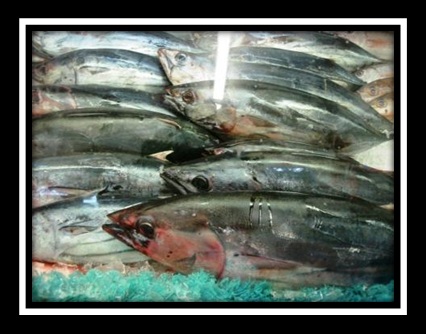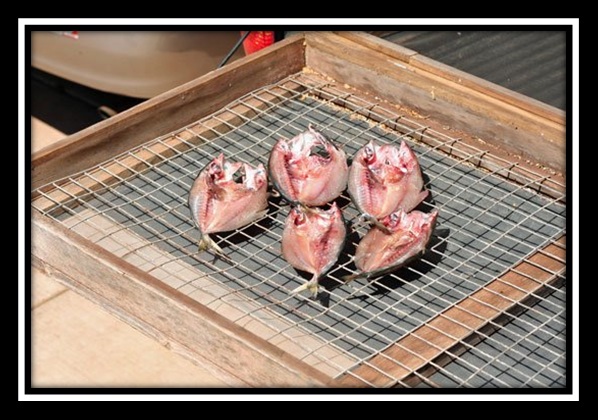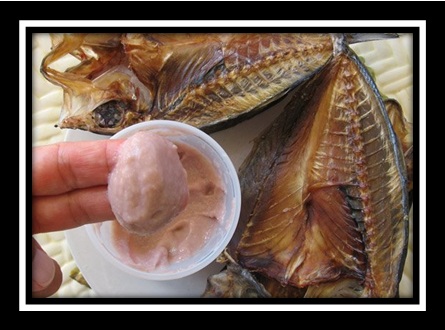Digital Collections
Celebrating the breadth and depth of Hawaiian knowledge. Amplifying Pacific voices of resiliency and hope. Recording the wisdom of past and present to help shape our future.
E Hoʻolako Mau, Volume II: All Hawaiian Cook Book. Tamar Luke Paneʻe. 1987.
INGREDIENTS:
2 akule, cleaned and scaled
MARINADE I
4 tablespoons Hawaiian salt
1 cup water
MARINADE II
½ cup shoyu
4 tablespoons sugar
¼ teaspoon monosodium glutamate (optional)
DIRECTIONS:
Cut fish in half, lengthwise from the back of the head to its tail.
Remove insides and wash or wipe fish clean.
Marinate in brine solution or shoyu mixture for 1–2 hours.
Sun-dry 1–2 days (depending on the size of the fish) in a dry box or place on a rack in a shallow roasting pan and dry in the oven at 225 degrees F. 4–5 hours.
To serve, broil to heat through.
About Fish
Traditionally, fish was never boned because the flesh on the bones was considered especially sweet. The dark meat next to the spine of ʻahi, aku, and kawakawa, was especially preferred. Even the eyes of the large fish were considered delicious.
Roe was seldom eaten because fish was never caught when it was laden with eggs. The flavor was considered a poor man’s dish. However, some people enjoyed eating the roe of the mahimahi. It is said that it was delicious when dried or broiled. Sometimes it was added to the palu.
Fish was eaten raw, cooked, or salted and dried. Raw fish was, and still is relished by many. Hawaiians continue to eat the whole fish, except the bones. Anyone who picked at the fish served, discarding the dark flesh near the bones, or the skin of any except a very tough-skinned fish, or a strong smelling fish was not considered a cultivated person.
Fish was never served without some preparation. Fresh fish was always salted. If it was preferred, the blood from the gills was squeezed out on to the flesh. If not, the blood was rinsed off. Spearing fish was not a good way to catch fish if it was eaten raw because of the loss of the blood.
Fish was salted to various degrees. Fresh fish to be eaten immediately was kāhunahuna (salted). When the salt had penetrated the flesh, it was at the ʻūʻū stage. Before serving, the excess salt was kaka (rinsed off). When well salted through-out it was maliʻu. When it was wīkani (stiff and hard) the fish became uāniʻi (white with salt). The process of rubbing in salt is kōpī (or kāpī).
Fish was dried to eat when storms prevented fishing. There were two stages of drying fish; iʻa maemae (partly dried), for keeping a short time only and iʻa maloʻo or iʻa kaulaʻi (for keeping a longer period). When well dried, many fish became hard and stiff. Heads were usually left on then generously kōpī (salted).
Dried fish was eaten without further preparation or was broiled. If only partly dried the fish would remain a little moist when broiled. To soften the fish if it became too dry after broiling, it was softened in a dish of water. Hawaiians have a great fondness for salt in their food. It was possible to make a meal of poi with salt. Fish or meat was always salted for good eating.
About Akule
(Mackerel, Big-Eyed Scad)
Akule is a schooling fish inhabiting the mid or surface waters along the coasts of all the islands. The young often swim close to shore into protected bays and harbors. The young fish or halalū offer great sport to shore anglers fishing with light spinning tackle and most are caught from about July to December.
Adult fish are found offshore where they are netted or hand-lined in season by commercial fishermen.
Its color is olive green on the dorsal area, golden or silvery on the sides and head; its tail fin yellow and a faint spot on the mahamaha (gill) cover. Scales are small.
Found abundantly in the big bays of the islands, especially Kauaʻi; sometimes called “the fish of Hanalei.” When a school was surrounded, a kahuna (priest) or kilo (watcher) would pick out the first fish, and throw it back into the sea, with a prayer to the local fish god, or Kūʻula himself.
Eaten raw, broiled, dried, and cooked; it is good for palu.

photo credit: Tyler & Chris Mercier
Freshly caught ʻahi and other types of fish can be found at your local fish auction.

photo credit: Rowena Castelli
A simple tasty meal of dried fish and poi, perfect for any time of year!

photo credit: Lynne Lariset
Akule are also known as big-eyed scad. You can see why they get this name, their eyes are HUGE!

photo credit: Rowena Castelli
A simple tasty meal of dried fish and poi is perfect for any time of year!